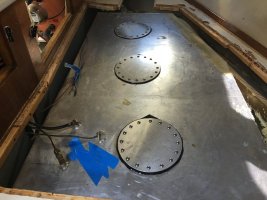Flight Risk
Member II
All tanks get water in them eventually......
Regarding water in your tanks, it is like russian roulette, someday it will happen. Deck fill pipe o-rings can fail. Vent tubes get slapped with water during hull detailing..... Or more typical, it comes from a crummy load of fuel with water entrained in it thay will condense in your nice cool below water line tank..... Most fuel suppliers have water block type filters on their pumps and tanks. These usually do a good job.
However, I do not trust my fuel injection components to some flunky whose job it is to change the pump filters when they remember to...... Install a good fuel water separator in your fuel lines, drain it regularly and change the filter every time you service the engine. If you have inspection ports, a leg up for you! Dessicant filters on tank vents are more common these days on luxury yachts and they are a good idea in humid areas (are sail boats ever in humid areas????).
Lastly, about every five years or so, change out the rubber fuel lines and pump out the last bit of fuel in your tank to get the sludge or other gunk out. Planned maintenance beats un-planned failure every time!
Chris
E-34 Flight Risk
Regarding water in your tanks, it is like russian roulette, someday it will happen. Deck fill pipe o-rings can fail. Vent tubes get slapped with water during hull detailing..... Or more typical, it comes from a crummy load of fuel with water entrained in it thay will condense in your nice cool below water line tank..... Most fuel suppliers have water block type filters on their pumps and tanks. These usually do a good job.
However, I do not trust my fuel injection components to some flunky whose job it is to change the pump filters when they remember to...... Install a good fuel water separator in your fuel lines, drain it regularly and change the filter every time you service the engine. If you have inspection ports, a leg up for you! Dessicant filters on tank vents are more common these days on luxury yachts and they are a good idea in humid areas (are sail boats ever in humid areas????).
Lastly, about every five years or so, change out the rubber fuel lines and pump out the last bit of fuel in your tank to get the sludge or other gunk out. Planned maintenance beats un-planned failure every time!
Chris
E-34 Flight Risk

